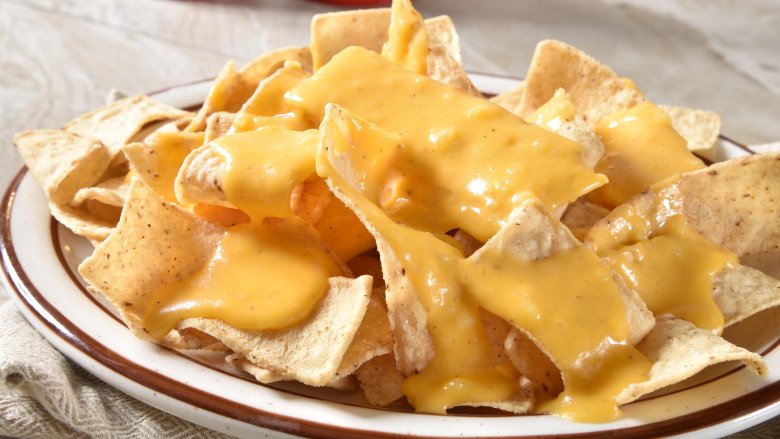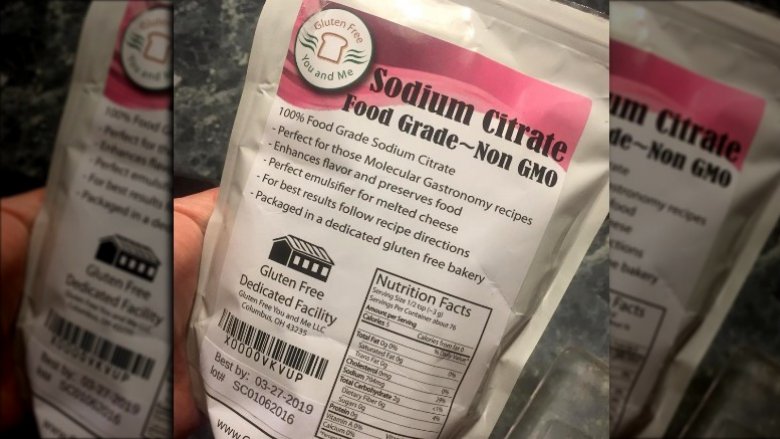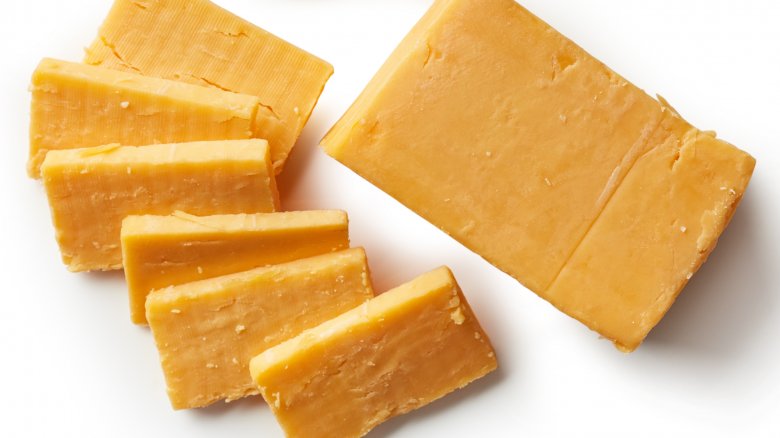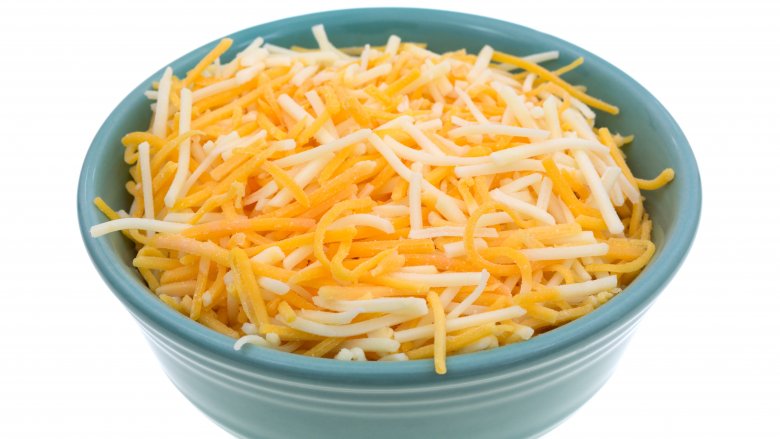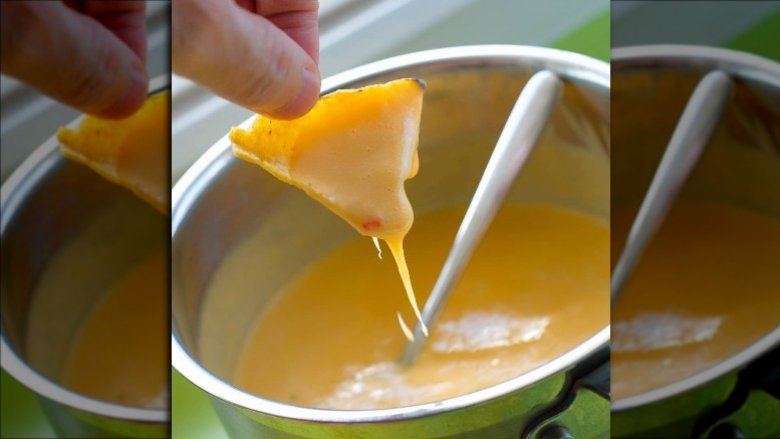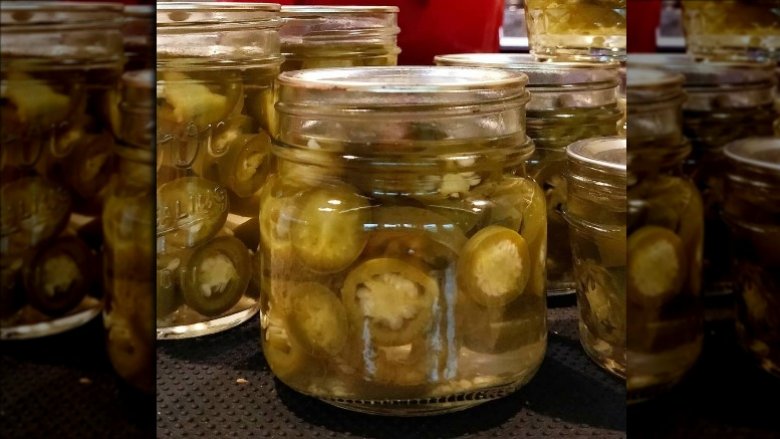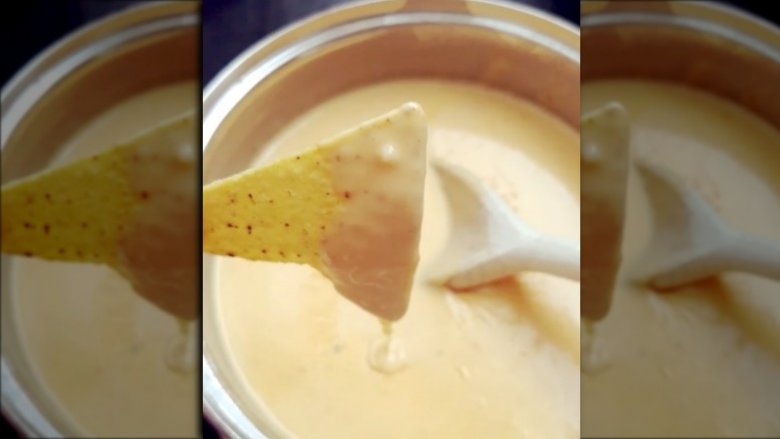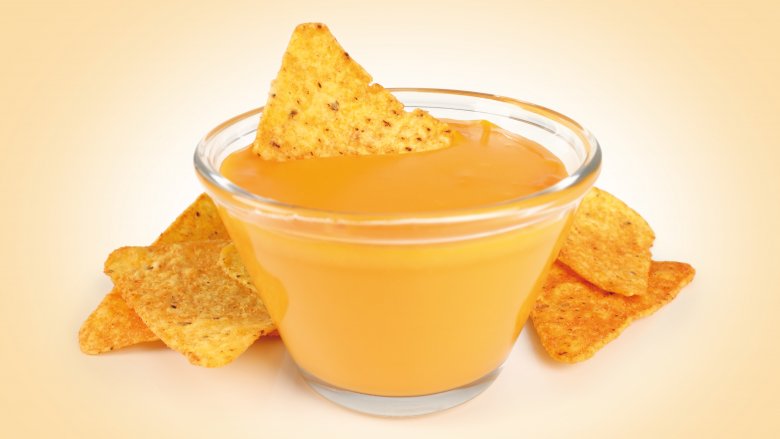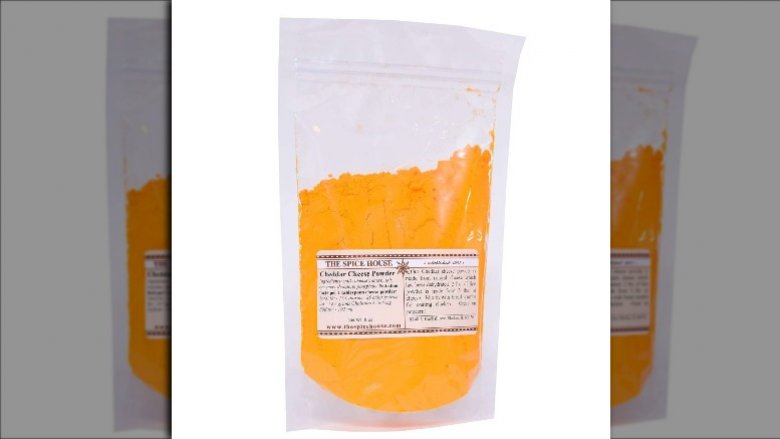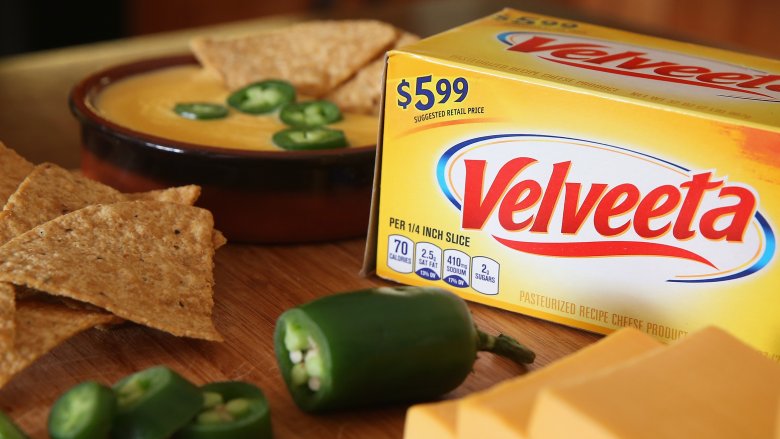Mistakes Everyone Makes When Making Nacho Cheese
We may receive a commission on purchases made from links.
Movie theaters, stadiums, amusement parks, carnivals... what do they all have in common? Nachos. Nachos topped with the creamiest, dreamiest cheese sauce your tortilla chips ever did meet. The problem is, sometimes you want to satisfy that nacho craving from the comfort of your own home, and if you've ever tried to replicate this pourable cheese yourself, you might have ended up with a pot full of sauce that's neither creamy nor dreamy, but is instead lumpy, clumpy, grainy, or greasy — or worse, all of the above.
How do these cheese sauce magicians get that perfectly smooth consistency every time? And why doesn't your cheese sauce have that certain flavor your beloved ballpark nachos always have? We mined a Reddit thread for all the best nacho cheese-making advice — plus added in a few useful tips of our own — to ensure that you achieve creamy and dreamy every time, and say goodbye to lumpy, clumpy, grainy, and greasy cheese sauce for good.
You're not using this magic ingredient
According to Redditors who know their nacho cheese, the key to perfectly smooth and creamy sauce is sodium citrate. This ingredient is said to be the secret to avoiding many of your nacho cheese woes, and as one sodium citrate advocate put it, "It keeps melted cheeses from breaking, basically turning everything into Velveeta." Sold.
Modernist Cuisine is frequently cited as one of the originators of this method, and they claim that their basic pepper jack nacho cheese is always thought to contain either cream or butter due to its impossibly smooth consistency. But no, it only contains cheese, beer (or water), and sodium citrate. Huff Post reports that though this ingredient might sound a little scary, it's actually just a "form of salt that works as an emulsifier," which prevents the cheese from separating and creating that greasy, clumpy mess. You only need 1/2 teaspoon of sodium citrate (mixed with about 1/2 cup of liquid) for each 8 ounces of finely grated cheese to whisk up the best nacho topping you've ever made.
You're using the wrong cheese
As tempting as it may be to upgrade your nacho cheese with fancier options like a delicious hunk of aged, sharp cheddar, it's not the single best choice if you're looking for that Velveeta-like creaminess.
For the best gooey nacho cheese, you'll want to stick to the softer cheeses that contain plenty of moisture, like mild cheddar or jack — these choices are made for melting. Aged cheeses on the other hand, which tend to be crumbly (think Parmesan or extra-sharp cheddar), can lead to a grainy texture. Thankfully, it is possible to get the best of both worlds, retaining the high meltability while also getting some of that aged cheese punch. According to Thomas Joseph of Kitchen Conundrums, the key is to use those crumbly cheeses in moderation — combining 2 cups of softer cheese with 1/2 cup of an aged cheese, for example — which will give your sauce a flavor boost without sacrificing in the consistency department.
You're using pre-shredded cheese
Now that you know what types of cheese you should be using, you might be tempted to head straight for the dairy case and grab a couple bags of pre-shredded cheddar and jack. It's the ultimate time-saver, after all — who needs to waste time shredding cheese when you can buy it already done? We've got bad news for the grater-averse: When it comes to making nacho cheese, it's best to avoid this convenience food.
If you've ever used pre-shredded cheese, you've probably noticed that each tiny shred is coated in... something. That "something" is typically a combination of ingredients (potato starch, powdered cellulose, and natamycin) used, in part, to prevent mold and clumping. And unfortunately, it is not nacho cheese's friend. Just as the anti-clumping agent will prevent the shreds from fusing together in the bag, it also prevents them from melting together properly when heated. Another con? Pre-shredded cheese is much drier than freshly grated, and as we've already learned, higher moisture content is a plus when it comes to a creamy end result.
You're not using this ingredient combo
If you're still not sold on the sodium citrate idea, you might like this method laid out by J. Kenji López-Alt of Serious Eats, which uses two ingredients you probably have in your pantry: Evaporated milk and cornstarch.
López-Alt set out to make a nacho cheese sauce comparable to those pumped out of spigots in the fast food restaurants, but with real cheese. After some experimenting, he landed on the combination of 8 ounces grated cheese (tossed with 1 tablespoon cornstarch) and 12 ounces evaporated milk. As he explains it, the evaporated milk contains concentrated milk proteins, which help stabilize and emulsify the cheese sauce, preventing the oily separation that frequently occurs when melting cheese. The cornstarch helps to keep the emulsion together, while also preventing the proteins and fats from fusing as the temperature goes down. Because of this, even when cool, the nacho cheese will stay perfectly smooth and creamy. Just like Fuddruckers, but better.
You're not adding this flavor enhancer
If you've been searching for a recipe that tastes just like ballpark nacho cheese, you've come to the right place. This was a hot topic amongst Redditors who wanted to know why their homemade nacho cheese never tastes the same as the nacho cheese they get at the stadium. No matter what method they try, it's always lacking that certain something.
According to a few users in the know, that certain something you're missing is pickled jalapeño brine. Yep, the juice from a store-bought jar of pickled jalapeños. And while you can add the brine to any recipe you're making, you definitely don't need to complicate things by making a fancy cheese sauce. That's because, apparently, the other key to that unmistakable flavor and texture is canned nacho cheese. One Redditor explains that your search for the holy grail of ballpark nacho cheese ends with nothing more than "canned Rico brand cheese mixed with some of the brine from pickled jalapeños." While it might sound too simple, it makes sense — do we really think there's a nacho cheese-making chef whipping up artisanal cheese sauce in bulk at the ball game? Probably not.
You're making your roux wrong
If you're starting your nacho cheese sauce with a roux, you might have two complaints about the finished product: 1. It tastes like raw flour. 2. It's lumpy.
A roux is a thickening agent made of flour and fat that's used in sauces, and depending on what you're making, is cooked to a certain color — anywhere from white to dark brown. For a nacho cheese sauce, you would use a white roux, and since it's not cooked very long, it could lead to that telltale raw flour taste. The key to avoiding this is simple: Cook the flour thoroughly in the fat, about 5 minutes, until the raw flour smell is gone.
Onto the lumps. Once your fat and flour mixture is well combined and cooked, slowly whisk the milk into the roux. Slowly is the key word here. By adding the milk a little at a time, you'll ensure that you've incorporated all of the flour from the bottom of the pan thoroughly into the liquid, which will result in a super smooth cheese sauce. And though you'll see recommendations that the milk must be a certain temperature to achieve ultimate smoothness, Serious Eats has determined that cold or warm, it really doesn't make a difference when it comes to lumps.
You're using too much heat
We get it — once a nacho craving hits, it can be hard to wait for the cheese to melt oh-so-slowly over a low flame. Unfortunately, turning the heat up isn't going to help matters any. In fact, high heat will likely lead to a cheese sauce fail.
According to ThermoWorks, there is a just-right temperature at which to melt your cheese, and going above that melting point (which happens to be 150 degrees for cheddar cheese) will cause the proteins to seize up. Once the seize occurs, you'll be looking at a separated, oily mess, and there's no going back from it. For the meltiest, creamiest results, finely shred the cheese, and let it come to room temperature before heating. These two extra steps mean that you won't need to use as much heat to reach the melting point, and lower, gentler heat equals better nacho cheese.
You're not using cheese powder
Fans of Kraft Macaroni & Cheese will want to pay close attention to this useful nacho cheese-making tip, which puts the familiar neon orange cheese powder to good use when a chip and dip craving strikes. Yes, you can now buy dehydrated cheddar cheese powder — which is described as smooth, velvety, strong, and tangy — that you can sprinkle straight onto popcorn and vegetables, or reconstitute into cheese liquid. What a time to be alive.
As one Redditor explains, "It's a little insane, but you can work lovely nacho-cheese miracles with dehydrated cheese powder. If you want it like stadium/bowling alley/cafeteria nacho cheese, a little of this stuff rehydrated with butter & water, seasoned to taste, is like childhood coming back to life. It's gross, but it's made of real cheese originally, so maybe it's less gross." And by gross, we're assuming they mean 100 percent delicious.
You're not using the easiest shortcut of all
After all this talk about the best cheeses to use, and how to make a roux properly, and why would should use sodium citrate, we're going to leave you with one last tip, and it happens to be the easiest nacho cheese hack out there (aside from just opening a jar, of course). Don't let this extensive five-step process deter you:
- Buy a block of Velveeta cheese.
- Buy a can of Ro-Tel tomatoes with green chiles.
- Dump cheese and tomatoes into a pan (or a bowl — yes, you can use the microwave for this fancy dip).
- Heat until melted.
- Eat.
The moral of the story? Nacho cheese made with a perfectly constructed roux and a blend of four cheeses will taste amazing, but so will cheese product mixed with pickled jalapeño brine and/or canned tomatoes. At the end of the day, all nacho cheese is good nacho cheese.
